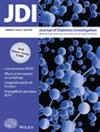Distinct patterns of hypogonadism in a cross-sectional study of Malaysian men with type 2 diabetes mellitus: The role of insulin resistance, visceral adiposity, and aging
Abstract
Introduction
Hypogonadism is common among male patients living with type 2 diabetes mellitus and can be divided into hypergonadotropic hypogonadism (hyper-H) and hypogonadotropic hypogonadism (hypo-H). Hypo-H is strongly linked to insulin resistance and visceral adiposity, while hyper-H in type 2 diabetes mellitus males has not been extensively studied. We aimed to study factors associated with the two subtypes of hypogonadal type 2 diabetes mellitus males in Malaysia, where obesity and poorly controlled diabetes are highly prevalent.
Patients and Methods
We screened 360 type 2 diabetes mellitus males for hypogonadism (H), defined by total testosterone <12 nmol/L, repeated calculated free testosterone <0.255 nmol/L, and Aging Male Symptoms (AMS) scale >26. Subjects were classified into hypogonadotropic hypogonadism (hypo-H) and hypergonadotropic hypogonadism (hyper-H) based on luteinizing hormone (LH) levels. We further analyzed their sociodemographic and clinical parameters in comparison to the control group of eugonadal males.
Results
55.6% of the 63 hypogonadal subjects have hypo-H. Significant differences in weight (P = 0.001), BMI (P < 0.001), waist circumference (P < 0.001), serum HDL-C (P < 0.001), serum triglycerides (P = 0.001) and TyG index (P < 0.001) were observed between hypo-H and eugonadal males. For hyper-H males, only age differed significantly from eugonadal males (P = 0.034).
Conclusions
Age is significantly associated with hyper-H, while insulin resistance and visceral adiposity are strongly linked to hypo-H. Older and obese Malaysian type 2 diabetes mellitus males, particularly those with coronary artery disease and lower HDL-C levels, are at a higher risk of developing hypogonadism. Diabetic treatments aimed at improving insulin resistance and reducing visceral adiposity could be highly effective for hypogonadal type 2 diabetes mellitus males in Malaysia.


 求助内容:
求助内容: 应助结果提醒方式:
应助结果提醒方式:


